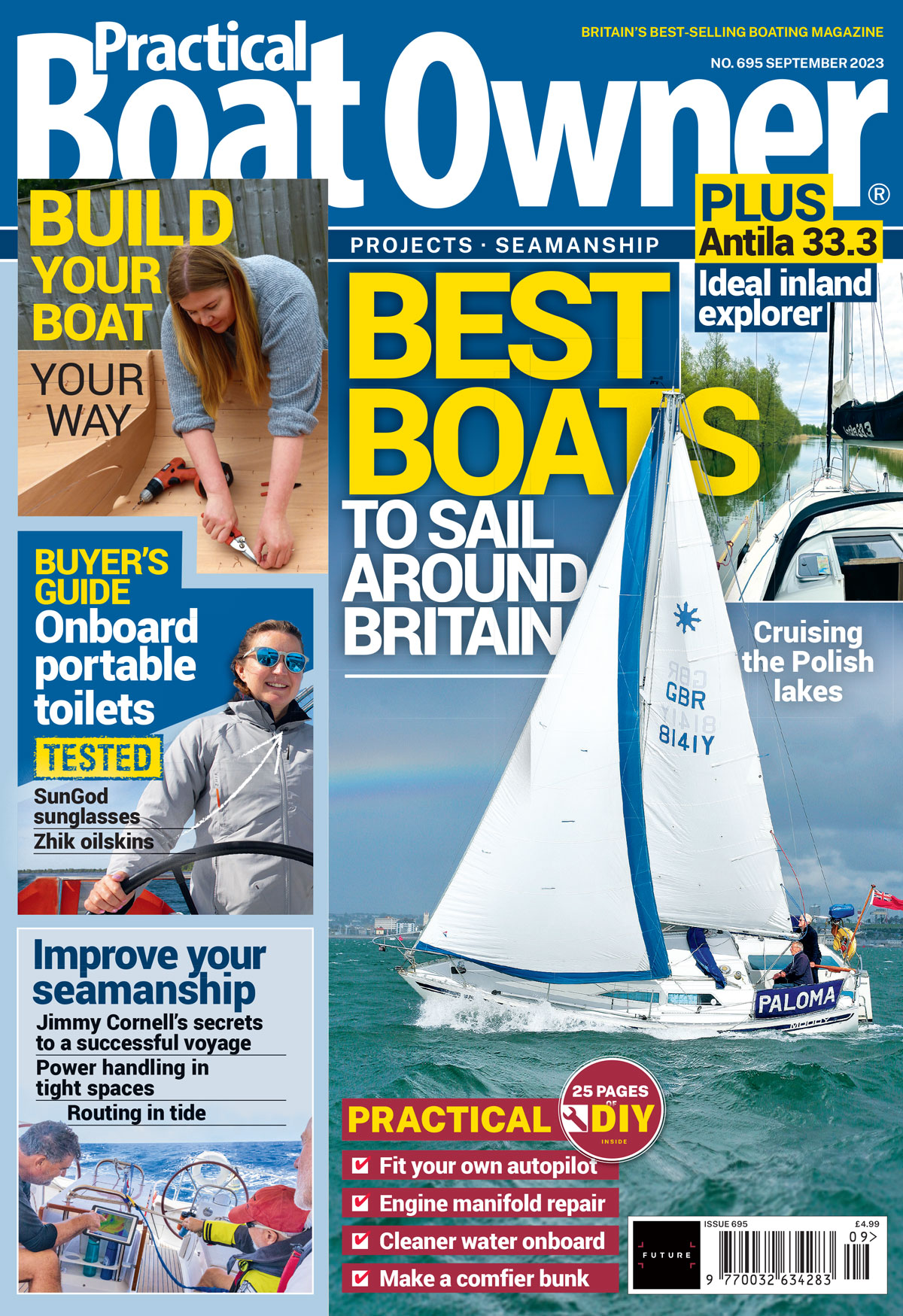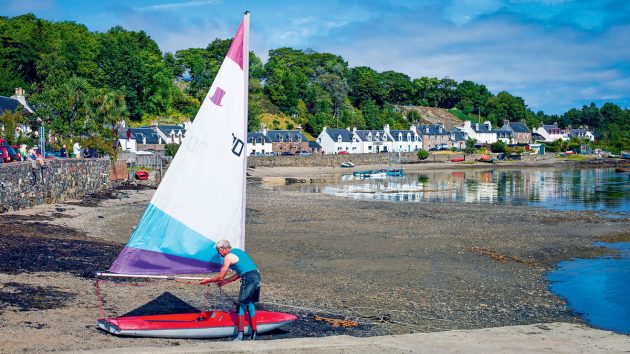Clive Marsh looks at sailing surfboats - the Seabat, Minisprint, Lightning 368 and more!
Even when living in a flat or townhouse with poor access to a drive or garden for a trailer-sailer you can keep your boat on a mooring or charter one when needed and that is just what I used to do.
But I also liked the idea of keeping a boat at home so that I could take her to different locations at the drop of a hat.
None of us in the UK are far from a stretch of water.
Eventually, I found a boat that I could carry on its side under my arm with my fingers through the daggerboard slot and get it into my small backyard.
I could store it vertically to take up less ground and even get it through the window into the sitting room had my wife been a bit more reasonable.
This lightweight boat was called a Seabat and it fuelled my ongoing interest in simple, light planing boats – the sort of boat that you can carry under your arm to the beach and launch in five minutes.
Sailing surfboats: The Seabat
The GRP Seabat is 11ft 6in/3.5m long with a beam of just 3ft 3in/1m. She has very little draught or freeboard and thus no great weight.
I could get her onto my car’s roof rack single-handed and carry her to launch from any beach I fancied.
I don’t recall her weight but she was the lightest boat I have owned. I expect the plywood version would be even lighter.
Given her light weight and hull shape, she would plane easily.

Clive on his Seabat in 1972. Credit: Clive Marsh
Sitting out with feet under tow straps she was extremely fast until she heeled too far when either deck went under the waves and I would inevitably capsize her.
She was very easy to capsize but also easy to right again. On a summer’s day, a good capsize was part of the fun.
Seabats have a lateen sail of 72ft2/6.7m2 that could not be reefed so I would have to spill wind at times.
But the low centre of effort enabled her to carry a good sized sail as long as you were agile enough to provide ballast in the right place at the right time.
This was a constant challenge for me. But the great advantage of the boat was that she fitted neatly on top of my VW Beetle and I could go sailing or swimming any time at the drop of a hat and have her rigged and in the water in a trice!
I have sailed her off Eastbourne, Shoreham and Priory Bay on the Isle of Wight and on one occasion even with a precariously balanced passenger.
Alas, these clever little boats are no longer made and people have moved onto windsurfers which are all well and good if you like to sail standing up all day.
However, Seabats are featured on the Classic and Vintage Racing Dinghy Association (CVRDA) website and you might find one for sale at an event.
Sailing surfboats: The Minisail and Minisprint
The Seabat had given me a taste for simple sail surfing and I decided to buy a larger boat with an active class association.
So my next sailing surfboard was a 13ft Minisail, complete with a sliding seat, designed by Ian Proctor and known as the Minisprint variant.
These boats became popular in the 1960s and I remember being impressed by their planing and ability to cope with surf off Brighton beach, often being sailed by helmsmen standing up.
This was before windsurfers had been invented or adopted and perhaps this is what introduced windsurfers to their athletic method of sailing.
Continues below…
Drascombe & Devon Lugger vs the Dabber
Designed for safe family boating under sail, or or power, but taken long distance by intrepid sailors, Clive Marsh looks…
Cornish Cormorant used boat report: The day boat that feels much longer than 12ft
The Cornish Cormorant is an attractive cat-rigged dinghy and I was very pleased when Alex at Anglia Yacht Brokerage was…
Winchelsea Lugger used boat report: A 14ft beach boat that can cross the Channel
Sussex beach boats and their Flobart sisters on the other side of the channel are amongst my favourite luggers. In…
Half a million Sunfish dinghies sold: What is the secret to its success?
Today Britain is the world’s largest producer of sailing dinghies, but the story was different 50 to 60 years ago,…
The Minisail is heavier than the Seabat but can be carried to the beach by two people or dragged along on a trolley or skid.
She could be rigged and launched in a few minutes and even by today’s standards she was very fast to plane.
The sliding seat took some getting used to and required quick reactions, especially in gusty conditions.
However, when rigged with a sliding seat and if the conditions were favourable she was a very hard boat for others to beat.
Eight of these boats were presented to HMS Devonshire and were described as the finest piece of sports equipment the ship ever had.
Minisails are still raced by enthusiasts around the country and you can find details of their specifications on the CVRDA website.
Lightning 368
My next sailing surfboat was a Lightning 368 complete with centreboard. She was a sophisticated bit of kit.
I had considered a Laser but decided to buy a Lightning 368 because she had a centreboard and was also a few kilograms lighter than the Laser.
The centreboard had all the advantages you’d expect and the main one for me was the ease of raising the board when beaching.
However, on a shingle beach I did from time to time get stones stuck up the casing, and I can tell you that it’s easier to push stones out of the casing with a daggerboard than it is with a centreboard.
To my eye, she’s a very attractive, nicely proportioned and well built boat.

A Lightning 368 built by John Claridge. Credit: John Claridge
A strict one design single hander originally designed by Mark Giles and currently built by John Claridge, the Lightning 368 looks just right and is a bit of an eye turner.
She is easily handled ashore and afloat. The first time out with her was on a coastal lake in a gusting Force 4.
I had rigged her with the larger sail! This was great fun but too much for my modest weight and I needed to spill too much wind.
So I normally sailed her with the smaller sail except in light winds. I easily managed about 10 knots but I see that the current Mk3 version claims 17 to 20 knots and I don’t doubt that with a fit sailor.
So if you want speed without foils and would rather sit down than stand on a windsurfer this could be the boat for you.
I wish I hadn’t sold her but keeping too many boats in commission is just a load of work.
However, I would like to buy another one day. Lightning 368s are one of my favourite light boats.
Other small sailing surfboats
There are many other popular sailing surfboats that I have not owned. These include that tough little Topper and the elegant Laser.
These popular boats have very active class associations.
The Topper weighs just 43kg and its unique polypropylene construction makes the boat virtually indestructible.
Toppers are very low maintenance, easily car topped and carried into a back yard.
They have a range of sail areas to suit different levels of crew weight and skill.

Laser dinghy in action – or sailing surfboat as Clive likes to call them. Credit: Derek Braid/Alamy
Laser dinghies weigh 59kg and are easier to launch through a little surf than many dinghies.
More suited to a heavier crew than a Topper they are elegant boats and are widely produced.
There are more than 215,000 of these boats worldwide and Lasers have been an Olympic class since 1996.
Other light boats to consider include the Moth, Blaze, Byte, Comet, Concept 302, Europe, Laser Pico, Nimbus, Phantom, RS600 (very fast), Splash, Streaker, Supernova and the Toy, to name just a few.
There is plenty of choice and if you live in a town centre with not much space you might still be able to keep one of these light, slim boats at home ready to escape for a weekend or evening sail. Just charter a yacht for holidays.
Enjoyed reading this article? 
A subscription to Practical Boat Owner magazine costs around 40% less than the cover price.
Print and digital editions are available through Magazines Direct – where you can also find the latest deals.
PBO is packed with information to help you get the most from boat ownership – whether sail or power.
-
-
-
- Take your DIY skills to the next level with trusted advice on boat maintenance and repairs
- Impartial in-depth gear reviews
- Practical cruising tips for making the most of your time afloat
-
-








